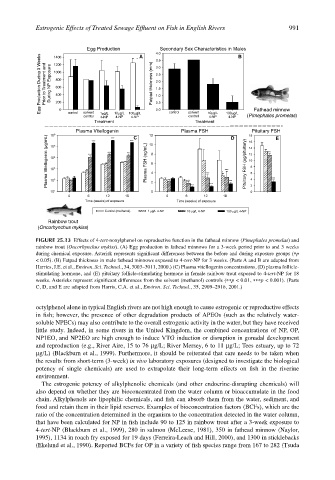Page 1011 - The Toxicology of Fishes
P. 1011
Estrogenic Effects of Treated Sewage Effluent on Fish in English Rivers 991
Egg Production A Secondary Sex Characteristics in Males
Egg Production During 3 Weeks Prior to Treatment and During NP Exposure Fatpad thickness (mm)
B
Fathead minnow
(Pimephales promelas)
Treatment Treatment
Plasma Vitellogenin C Plasma FSH D Pituitary FSH
Plasma Vitellogenin (µg/mL) Plasma FSH (ng/mL) Pituitary FSH (µg/pituitary)
E
Rainbow trout
(Oncorhynchus mykiss)
FIGURE 25.13 Effects of 4-tert-nonylphenol on reproductive function in the fathead minnow (Pimephales promelas) and
rainbow trout (Oncorhynchus mykiss). (A) Egg production in fathead minnows for a 3-week period prior to and 3 weeks
during chemical exposure. Asterisk represents significant differences between the before and during exposure groups (∗p
< 0.05). (B) Fatpad thickness in male fathead minnows exposed to 4-tert-NP for 3 weeks. (Parts A and B are adapted from
Harries, J.E. et al., Environ. Sci. Technol., 34, 3003–3011, 2000.) (C) Plasma vitellogenin concentrations, (D) plasma follicle-
stimulating hormone, and (E) pituitary follicle-stimulating hormone in female rainbow trout exposed to 4-tert-NP for 18
weeks. Asterisks represent significant differences from the solvent (methanol) controls (∗∗p < 0.01, ∗∗∗p < 0.001). (Parts
C, D, and E are adapted from Harris, C.A. et al., Environ. Sci. Technol., 35, 2909–2916, 2001.)
octylphenol alone in typical English rivers are not high enough to cause estrogenic or reproductive effects
in fish; however, the presence of other degradation products of APEOs (such as the relatively water-
soluble NPECs) may also contribute to the overall estrogenic activity in the water, but they have received
little study. Indeed, in some rivers in the United Kingdom, the combined concentrations of NP, OP,
NP1EO, and NP2EO are high enough to induce VTG induction or disruption in gonadal development
and reproduction (e.g., River Aire, 15 to 76 µg/L; River Mersey, 6 to 11 µg/L; Tees estuary, up to 72
µg/L) (Blackburn et al., 1999). Furthermore, it should be reiterated that care needs to be taken when
the results from short-term (3-week) in vivo laboratory exposures (designed to investigate the biological
potency of single chemicals) are used to extrapolate their long-term effects on fish in the riverine
environment.
The estrogenic potency of alkylphenolic chemicals (and other endocrine-disrupting chemicals) will
also depend on whether they are bioconcentrated from the water column or bioaccumulate in the food
chain. Alkylphenols are lipophilic chemicals, and fish can absorb them from the water, sediment, and
food and retain them in their lipid reserves. Examples of bioconcentration factors (BCFs), which are the
ratio of the concentration determined in the organism to the concentration detected in the water column,
that have been calculated for NP in fish include 90 to 125 in rainbow trout after a 3-week exposure to
4-tert-NP (Blackburn et al., 1999), 280 in salmon (McLeese, 1981), 350 in fathead minnow (Naylor,
1995), 1134 in roach fry exposed for 19 days (Ferreira-Leach and Hill, 2000), and 1300 in sticklebacks
(Ekelund et al., 1990). Reported BCFs for OP in a variety of fish species range from 167 to 282 (Tsuda

